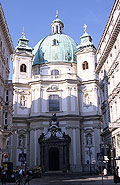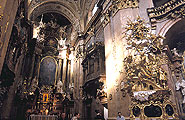
Throughout Europe, the artistic style of the Renaissance (approximately 15th and 16th centuries) drew inspiration from the study and imitation of the Classical art of ancient Greece and Rome. The Baroque era (late 16th- mid-18th centuries) followed, in which basic architectural forms still followed classical models (for example in columns and domes) but elaborate painting, statuary and carving, often violating the Classical restraint and sense of proportion, would be featured both externally and internally. One of the best known Baroque painters was the Flemish artist Rubens, who enjoyed the patronage of the Habsburgs, and whose paintings are featured in the Art History Museum in Vienna. Habsburg-ruled cities such as Prague and Vienna contain many examples of Baroque architecture, especially in the often extravagant churches.

One of the architects of the Church of St. Peter, Johann von Hildebrandt, also designed the upper Belvedere Palace for Prince Eugene of Savoy. In both its exterior and interior, the church is an excellent example of the Baroque architecture of the first third of the eighteenth century. Compare the interior decoration with that of the Baroque main altar in the Church of St. Michael.

Termed by one guide book as the "finest Baroque church" in Vienna, the Church of St. Charles Borromeo was commissioned by Emperor Karl VI in thanks for the end of the plague epidemic of 1713. The architect was one of the most famous in the empire, Johann Bernhard Fischer von Erlach, who also designed important churches in Habsburg Prague.
